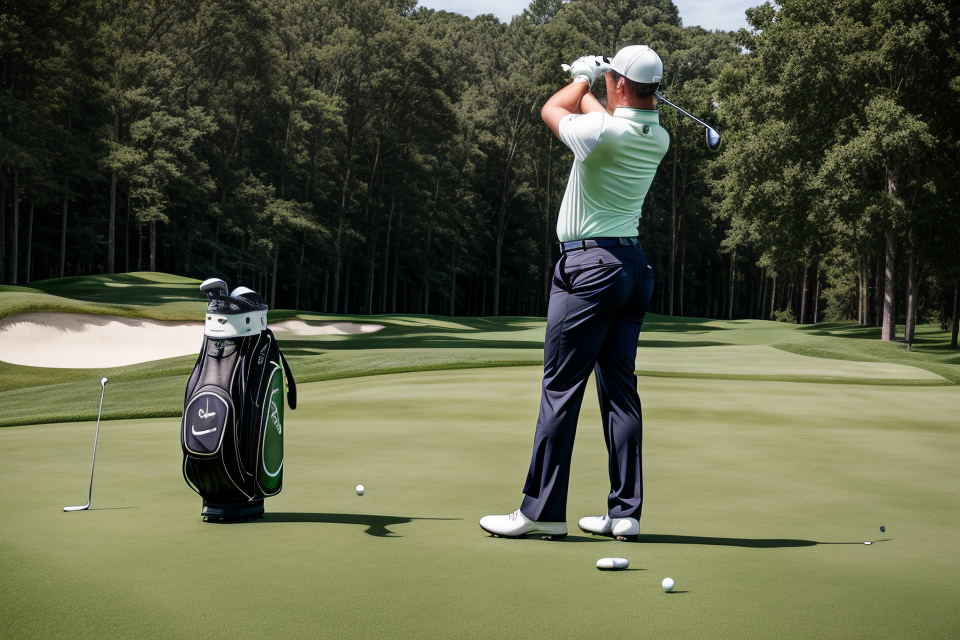
Golf is a game that requires precision, skill, and patience. While many factors can affect a golfer’s performance, the clubs they use play a crucial role. The question on many golfers’ minds is whether investing in the latest and greatest golf club technology will make a difference in their game. In this article, we will explore the impact of innovative golf club technology on performance, and whether it’s worth the investment. So, let’s tee off and find out if better golf clubs can give you the edge you need to hit that hole-in-one.
The Evolution of Golf Club Technology
The Emergence of Advanced Materials
Golf club technology has undergone significant transformations over the years, and one of the most significant advancements has been the emergence of advanced materials. These materials have played a crucial role in improving the performance of golf clubs, making them lighter, stronger, and more durable. Some of the most prominent advanced materials used in golf club technology include carbon fiber, titanium, and 3D printing.
Carbon Fiber
Carbon fiber is a high-performance material that is known for its exceptional strength-to-weight ratio. It is a lightweight, yet incredibly strong and stiff material that is used in the construction of golf club shafts. Carbon fiber shafts are popular among professional golfers because they offer a significant advantage in terms of swing speed and accuracy. They are also highly durable and resistant to wear and tear, making them a reliable choice for regular use.
Titanium
Titanium is another advanced material that has gained popularity in golf club technology. It is a lightweight metal that is known for its exceptional strength and durability. Titanium is used in the construction of golf club heads, as it allows for the creation of larger sweet spots and greater ball speed. Additionally, titanium is highly resistant to corrosion, making it an ideal choice for outdoor use.
3D Printing
3D printing technology has also played a significant role in the evolution of golf club technology. It allows for the creation of complex shapes and designs that were previously impossible to manufacture using traditional methods. 3D printing technology has enabled golf club manufacturers to create clubs with optimized shapes and weights, resulting in improved performance and greater accuracy. Additionally, 3D printing technology has made it possible to create custom-fit golf clubs that are tailored to the individual needs of each golfer.
In conclusion, the emergence of advanced materials such as carbon fiber, titanium, and 3D printing has had a significant impact on the performance of golf clubs. These materials have enabled manufacturers to create clubs that are lighter, stronger, and more durable, resulting in improved swing speed, accuracy, and overall performance. As technology continues to advance, it is likely that we will see even more innovative advancements in golf club technology in the years to come.
Innovations in Club Design
Adjustable Loft
Adjustable loft technology has revolutionized the way golfers customize their clubs to suit their individual swings. This innovation allows golfers to change the loft angle of the clubhead, which in turn affects the ball’s trajectory and distance. With adjustable loft technology, golfers can fine-tune their clubs to achieve the desired outcome for each shot, making it easier to hit the ball accurately and consistently.
Shaft Design
Innovations in shaft design have led to the development of golf clubs that are more forgiving and easier to control. Shafts are now made from advanced materials like graphite and carbon fiber, which allow for greater flexibility and more consistent ball flights. These materials also help to reduce the overall weight of the club, making it easier to swing and improving the golfer’s overall performance.
Grip Technology
Grip technology has also advanced significantly in recent years, with the development of specialized grips that help golfers maintain a more consistent hold on the club. This is particularly important for golfers with smaller hands or those who struggle to grip the club firmly. With these innovative grips, golfers can improve their control and accuracy, leading to better overall performance on the course.
The Rise of Distance and Accuracy
- Longer drives
Golf club technology has witnessed significant advancements over the years, and one of the most noticeable improvements has been the increase in driving distance. With the introduction of technologies such as larger clubheads, stronger shafts, and optimized ball designs, golfers are now able to hit the ball further than ever before. These longer drives have become a hallmark of modern golf, and have revolutionized the sport, making it more exciting for both professionals and amateurs alike. - Improved ball control
In addition to longer drives, innovative golf club technology has also led to improved ball control. With the development of new materials and manufacturing techniques, golf club designers have been able to create clubs that provide greater accuracy and control over the ball. This has resulted in golfers being able to shape shots more effectively, allowing them to navigate the course with greater precision and success. - Precision shot-making
Furthermore, the rise of distance and accuracy in golf club technology has also enabled golfers to make more precise shots. This has been achieved through the use of technologies such as adjustable lofts, which allow golfers to customize the trajectory and spin of their shots. Additionally, the use of high-tech materials and manufacturing techniques has led to greater consistency in club performance, resulting in more accurate and predictable ball flights. Overall, the rise of distance and accuracy in golf club technology has had a significant impact on the sport, making it more challenging and exciting for golfers of all skill levels.
Assessing the Impact of Technological Advancements
Factors Affecting Performance
- Swing mechanics
- The relationship between the golf club and the golfer’s swing mechanics is crucial in determining the performance of the club. Any innovation in the design of the golf club can significantly impact the golfer’s swing and ultimately affect the performance of the club. For instance, if a golfer uses a driver with a larger clubhead, it may require them to make adjustments to their swing to ensure proper contact with the ball.
- The size, shape, and weight of the clubhead can also impact the golfer’s swing mechanics. A heavier clubhead may require more effort from the golfer to control it during the swing, while a larger clubhead may require a different angle of attack to make contact with the ball.
- In addition, the materials used in the construction of the golf club can also affect the golfer’s swing mechanics. For example, a driver with a graphite shaft may be lighter and more flexible than a driver with a steel shaft, which can impact the golfer’s swing speed and control.
- Player skill level
- The skill level of the golfer is another important factor that affects the performance of the golf club. Higher-skilled golfers may be able to use more advanced technology in their clubs, such as adjustable loft and lie angles, while lower-skilled golfers may benefit more from simpler technology, such as a standard driver with a fixed loft angle.
- The skill level of the golfer can also impact the effectiveness of the innovative technology in the golf club. For example, a golfer with a slower swing speed may not benefit as much from a driver with a higher launch angle, as it may result in a shorter carry distance.
- Course conditions
- The conditions of the golf course can also impact the performance of the golf club. For example, if the course has tight fairways, a golfer may benefit from using a driver with a lower spin rate to ensure their ball reaches the green.
- Additionally, the weather conditions can also affect the performance of the golf club. For example, if it is windy, a golfer may benefit from using a driver with a higher loft angle to help control their ball flight.
- Furthermore, the condition of the turf on the golf course can also impact the performance of the golf club. For example, if the fairways are wet, a golfer may benefit from using a driver with a larger clubhead to help penetrate the turf and maintain ball speed.
Statistical Analysis of Technological Advantages
To accurately assess the impact of innovative golf club technology on performance, a comprehensive statistical analysis of the technological advantages must be conducted. This analysis will involve examining professional tournament data, amateur player performance, and comparing technology-enhanced clubs to traditional clubs.
Professional Tournament Data
Professional tournament data will be analyzed to determine the effectiveness of innovative golf club technology on the performance of professional golfers. This analysis will include a comparison of the performance of golfers using technology-enhanced clubs to those using traditional clubs. Factors such as driving distance, accuracy, and consistency will be taken into consideration. Additionally, the data will be analyzed to determine if there is a correlation between the use of innovative golf club technology and improved performance in professional tournaments.
Amateur Player Performance
The performance of amateur golfers will also be analyzed to determine the impact of innovative golf club technology on performance. This analysis will involve examining data from amateur tournaments and events, as well as data from amateur players who use technology-enhanced clubs. The data will be analyzed to determine if there is a correlation between the use of innovative golf club technology and improved performance in amateur tournaments and events.
Comparison of Technology-Enhanced Clubs vs. Traditional Clubs
To determine the impact of innovative golf club technology on performance, a comparison will be made between technology-enhanced clubs and traditional clubs. This comparison will involve examining data from professional and amateur tournaments and events, as well as data from players who use both technology-enhanced clubs and traditional clubs. The data will be analyzed to determine if there is a significant difference in performance between technology-enhanced clubs and traditional clubs.
Overall, the statistical analysis of technological advantages will provide valuable insights into the impact of innovative golf club technology on performance. The data collected will be used to determine the effectiveness of technology-enhanced clubs and to identify any potential advantages or disadvantages of using these clubs compared to traditional clubs.
The Debate: Is Technological Superiority Overrated?
The Traditionalist Perspective
- The importance of traditional club-making techniques
- Club-making has a rich history dating back to the 15th century
- Skilled craftsmen have honed their techniques over generations
- Each club is handcrafted with attention to detail and precision
- The role of natural skill and athleticism
- Golf is a sport that requires physical and mental prowess
- Traditional clubs demand more from the player, encouraging natural development
- The challenge of using traditional clubs enhances the overall golfing experience
- The purity of the sport
- Technology has not always been present in golf
- The game’s essence lies in its simplicity and tradition
- The use of innovative technology may compromise the sport’s core values
The Innovation Advocate Viewpoint
Embracing technological advancements to enhance performance
The Innovation Advocate perspective argues that technological advancements in golf clubs have significantly improved performance for skilled players. By utilizing cutting-edge materials and design principles, manufacturers have been able to create clubs that provide increased control, accuracy, and distance. These improvements have allowed professional golfers to fine-tune their swings and achieve better results on the course.
Adapting to modern club technology
The Innovation Advocate emphasizes the importance of embracing new golf club technology. By incorporating these advancements into their games, skilled players can stay ahead of the competition and maintain their performance levels. Adapting to modern club technology also helps golfers maintain their skills over time, as they age or their physical abilities change.
The future of golf club innovations
The Innovation Advocate viewpoint highlights the potential for continued technological advancements in golf clubs. As researchers and engineers continue to explore new materials and design principles, the potential for further performance improvements is substantial. In the future, golf clubs may be made from advanced materials that provide enhanced durability, or incorporate sophisticated sensors that track a player’s swing and offer real-time feedback.
By embracing technological advancements, adapting to modern club technology, and looking towards the future, the Innovation Advocate argues that technological superiority is essential for skilled golfers to maintain and improve their performance on the course.
Making an Informed Decision: Choosing the Right Clubs for Your Game
Assessing Your Needs
Choosing the right golf clubs is crucial for enhancing your performance on the course. To make an informed decision, it is essential to assess your needs as a player. Here are some factors to consider when selecting golf clubs:
Player type
The first step in assessing your needs is to identify your player type. Are you a distance player who prioritizes power and length off the tee? Or are you an accuracy player who values control and precision? Determining your player type will help you choose clubs that suit your game style and preferences.
Swing characteristics
Your swing characteristics are another critical factor to consider when choosing golf clubs. Factors such as swing speed, ball speed, and spin rate can affect your performance on the course. By analyzing your swing characteristics, you can select clubs that complement your swing and enhance your performance.
Budget
Finally, your budget is an essential consideration when choosing golf clubs. Golf clubs can range from affordable to expensive, and it is crucial to set a budget that aligns with your needs and preferences. By assessing your budget, you can narrow down your options and select clubs that offer the best value for your money.
In conclusion, assessing your needs is a crucial step in choosing the right golf clubs for your game. By considering factors such as player type, swing characteristics, and budget, you can make an informed decision that enhances your performance on the course.
Comparing Club Options
When it comes to choosing the right golf clubs for your game, there are several factors to consider. One of the most important is the type of technology used in the club. In this section, we will compare traditional vs. innovative technology and discuss the price range and brand reputation of each.
Traditional vs. Innovative Technology
Traditional golf clubs are made with standard materials, such as steel or titanium, and use a basic design. In contrast, innovative technology golf clubs are made with advanced materials and feature a more complex design. These clubs often incorporate new materials, such as carbon fiber or composite materials, to improve the club’s performance.
Some of the benefits of innovative technology golf clubs include increased distance, improved accuracy, and a more consistent ball flight. Additionally, many of these clubs are designed to be more forgiving, meaning that they will perform better for golfers with less precise swings.
However, it is important to note that not all innovative technology golf clubs are created equal. Some may be more effective for certain types of swings or golfers, while others may not provide any noticeable improvement.
Price Range
Another factor to consider when comparing golf club options is the price range. Traditional golf clubs are generally less expensive than innovative technology clubs. However, the price of innovative technology clubs can vary widely depending on the brand and the specific features of the club.
Some of the more expensive innovative technology clubs can cost several hundred dollars more than their traditional counterparts. However, it is important to remember that the price of a golf club is not always an indicator of its performance.
Brand Reputation
Finally, when comparing golf club options, it is important to consider the brand reputation of the club. Some brands are known for producing high-quality, high-performance golf clubs, while others may not have as strong of a reputation.
When evaluating brand reputation, it is important to consider factors such as the brand’s history, the quality of their products, and the opinions of other golfers. Additionally, it can be helpful to read reviews and seek out the advice of golf professionals before making a purchase.
In conclusion, when choosing the right golf clubs for your game, it is important to consider several factors, including the type of technology used, the price range, and the brand reputation. By carefully evaluating these factors, you can make an informed decision and choose the golf clubs that will best meet your needs and improve your performance on the course.
Seeking Expert Advice
When it comes to selecting the right golf clubs for your game, seeking expert advice can be a crucial step in making an informed decision. Golf professionals, club fitting experts, and online reviews and forums can all provide valuable insights and recommendations to help you choose the best clubs for your skill level and playing style.
Here are some key reasons why seeking expert advice can be beneficial:
- Golf Professionals: Golf professionals are trained to assess a player’s swing and recommend clubs that will optimize their performance. They can provide personalized recommendations based on factors such as ball flight, trajectory, and spin rate. Additionally, they can offer advice on how to adjust your swing to improve your overall game.
- Club Fitting Experts: Club fitting experts specialize in fitting golfers with clubs that are tailored to their individual swing and body type. They use technology such as launch monitors and swing analyzers to measure a player’s swing and recommend clubs that will optimize their performance. This can include custom-fitted shafts, grips, and clubheads.
- Online Reviews and Forums: Online reviews and forums can provide valuable insights from other golfers who have used a particular set of clubs. They can offer honest opinions on the clubs’ performance, durability, and overall value for money. However, it is important to take these reviews with a grain of salt, as some may be biased or inaccurate.
In conclusion, seeking expert advice can be a crucial step in making an informed decision when choosing golf clubs. Golf professionals, club fitting experts, and online reviews and forums can all provide valuable insights and recommendations to help you choose the best clubs for your skill level and playing style.
Trial and Evaluation
Evaluating the performance of innovative golf club technology requires a structured approach that combines both practical and on-course testing. To ensure an accurate assessment, it is crucial to follow a well-defined process that considers several factors, such as the golfer’s skill level, playing conditions, and personal preferences.
The following are some key steps to consider when evaluating the performance of innovative golf club technology:
- Practice sessions:
- The first step in evaluating the performance of new golf clubs is to practice with them in a controlled environment. This can be done by hitting balls onto a mat or a practice range, where the golfer can focus on making solid contact and getting a feel for the new clubs. It is essential to take note of any changes in ball flight, distance, and accuracy compared to the golfer’s current clubs.
- During practice sessions, it is also crucial to pay attention to any physical adjustments that may be necessary when using the new clubs. For example, the golfer may need to adjust their grip or stance to get the best results from the new technology.
- On-course testing:
- Once the golfer has practiced with the new clubs, it is time to take them onto the course for real-world testing. This is when the golfer can assess how the new clubs perform in various playing conditions, such as windy or wet conditions. It is important to keep track of the golf ball’s flight and landing pattern to determine if there are any significant differences compared to the golfer’s current clubs.
- On-course testing also provides an opportunity to evaluate the clubs’ overall performance, including distance, accuracy, and forgiveness. By comparing the new clubs to the golfer’s current clubs, the golfer can make an informed decision about whether to adopt the new technology or stick with their current equipment.
- Adjusting to new equipment:
- Finally, it is essential to give the golfer’s body time to adjust to the new equipment. Using new golf clubs can lead to changes in the golfer’s swing, which may affect their performance. It is crucial to allow the golfer’s body to adapt to the new equipment, and to be patient when evaluating its performance.
In conclusion, the trial and evaluation process is a critical step in making an informed decision about whether to adopt innovative golf club technology. By following a structured approach that combines practice sessions, on-course testing, and adjusting to new equipment, golfers can make an informed decision that will improve their performance on the course.
FAQs
1. What is the impact of innovative golf club technology on performance?
The impact of innovative golf club technology on performance can be significant. New materials, designs, and manufacturing processes can result in clubs that are more forgiving, have a better feel, and provide more control over shots. These improvements can lead to better accuracy, longer distance, and a more enjoyable golfing experience.
2. Are expensive golf clubs worth the investment?
Expensive golf clubs can be worth the investment for some golfers, especially those who play frequently or compete at a high level. High-end clubs are typically made with premium materials and advanced manufacturing techniques, which can result in improved performance. However, for casual golfers or those on a budget, the difference in performance may not be noticeable, and it may be more practical to invest in lower-priced clubs.
3. How do I choose the right golf clubs for my needs?
Choosing the right golf clubs for your needs depends on a variety of factors, including your skill level, playing style, and physical attributes. It’s important to consider the loft, shaft flex, and clubhead size when selecting clubs. A professional golfer or club fitter can help you determine the best clubs for your needs and provide expert advice on selecting the right equipment.
4. Can upgrading my golf clubs really improve my game?
Upgrading your golf clubs can certainly improve your game, but the extent of the improvement will depend on a variety of factors, including your skill level, physical attributes, and playing style. In general, better clubs can provide greater control, accuracy, and distance, which can help you improve your game. However, it’s important to remember that equipment is just one aspect of golf, and practice and skill development are also crucial to improving your performance on the course.
5. Are there any disadvantages to using innovative golf club technology?
There are some potential disadvantages to using innovative golf club technology. For example, some golfers may find that the newer clubs feel different or less familiar than their old clubs, which can affect their performance. Additionally, some golfers may find that the latest technology is too expensive or not compatible with their playing style. It’s important to consider your individual needs and preferences when selecting golf clubs and to choose equipment that feels comfortable and suits your game.


